
|
Toramana is the second king mentioned in the Schøyen copper scroll inscription, so his coins (and coins related to his) are presented
next. From the historian's point of view, Toramana is perhaps the most important Alchon king, because he is the first one about whom we have a
fair bit of information from sources other than coins. We know from an inscription dated in year 1 from Eran in central India (Madhya Pradesh) that he
was ruling there at the start of his reign and we also have an inscription from Kura in the Salt Range in the Punjab, naming him as mahararaja-
toramana-shahi-jauvla. These inscriptions suggest to me that he inherited a substantial kingdom reaching from northwestern Punjab to central India.
We then have later literary evidence of him waging war against the Guptas and installing a king in Magadha. Finally, the Gwalior Fort inscription
names him as the father of Mihirakula.
Until now, the only coins known of Toramana are copper coins (see below) and small silver drachms based on the Gupta madhyadesha
types (also see below). Vondrovec had left Toramana out of his analysis of the implications of the Schøyen inscription because there was no
known silver coin of his on the Sasanian model. However, listed below is one such coin. This gives us a huge boost in our ability to understand the
Alchon coinage.
Mihirakula must have inherited a sizeable kingdom, but it appears he lost most of it. An inscription in Mandasor proclaims that he was defeated by
Yashodharman, and accounts in the Rajatarangini tell us he was forced to flee to Kashmir, where the king gave him refuge. However, he turned
against his host and usurped power there.
|
 |
Precursor to Toramana ? |
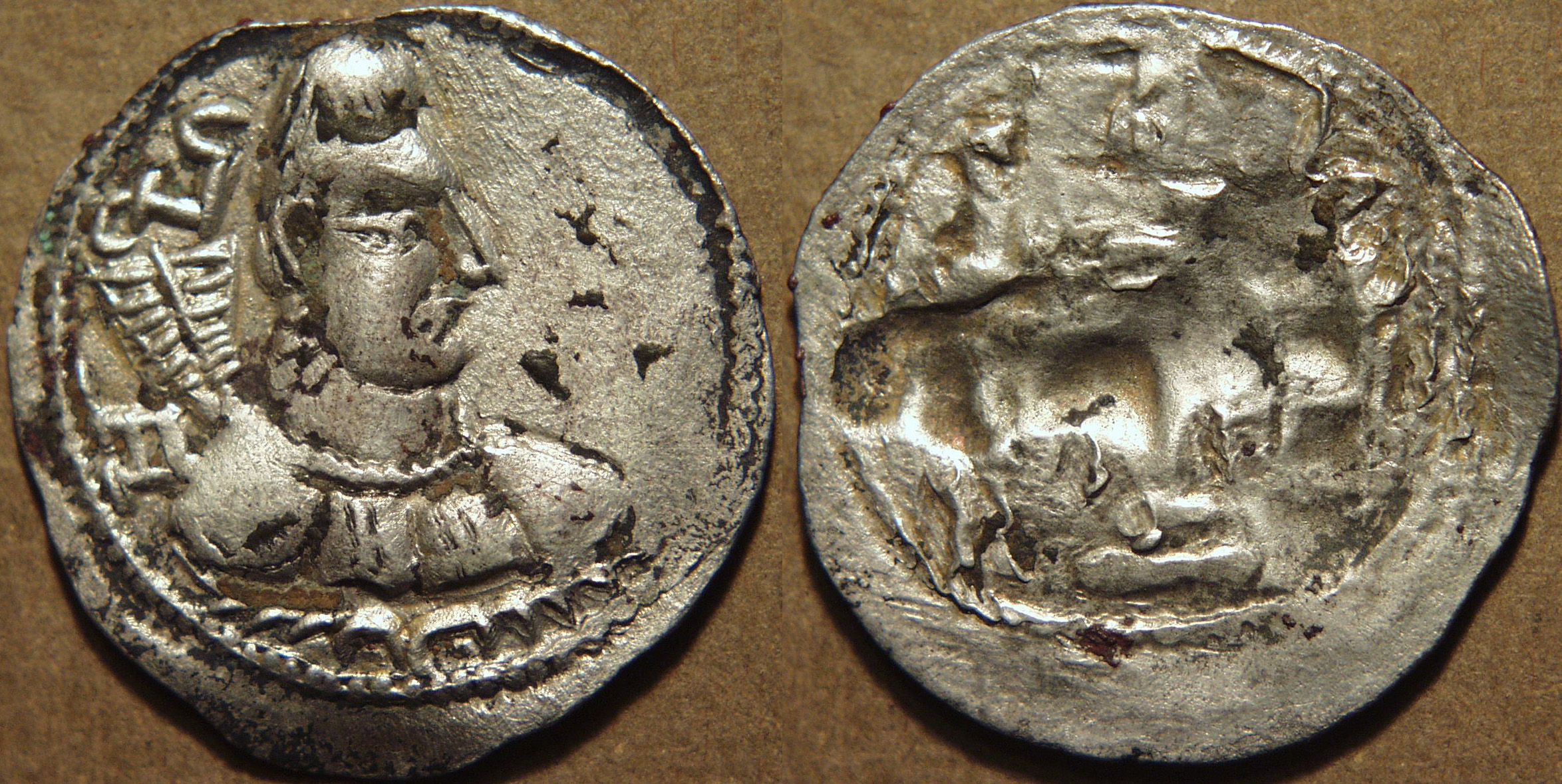
|
"Shahi" silver drachm, c. late-5th century
Bare-headed bust of king right, ribbon ends attached to necklace,
no "bull" tamgha, Brahmi legend at left: shahi /
Fire altar, flanked by armed attendants
Weight: 3.40 gm, Diameter: 28 mm., Die axis: 3 o'clock
Ref: Göbl 69
|
 |
This coin type is normally assigned to Khingila, but I would like to suggest the possibility that this
was a precursor to Toramana's coinage. The reason? It lacks the "bull"/lunar tamgha, which is present on all of Khingila's coinage (and also that of
Javukha and Mehama, as we will see), but which is absent on the coins of Toramana and Mihirakula. Thus it could form a bridge from the early anonymous
coins to the later named ones. Of course, this suggestion is highly tentative.
|
 |
 |
 |
Toramana |
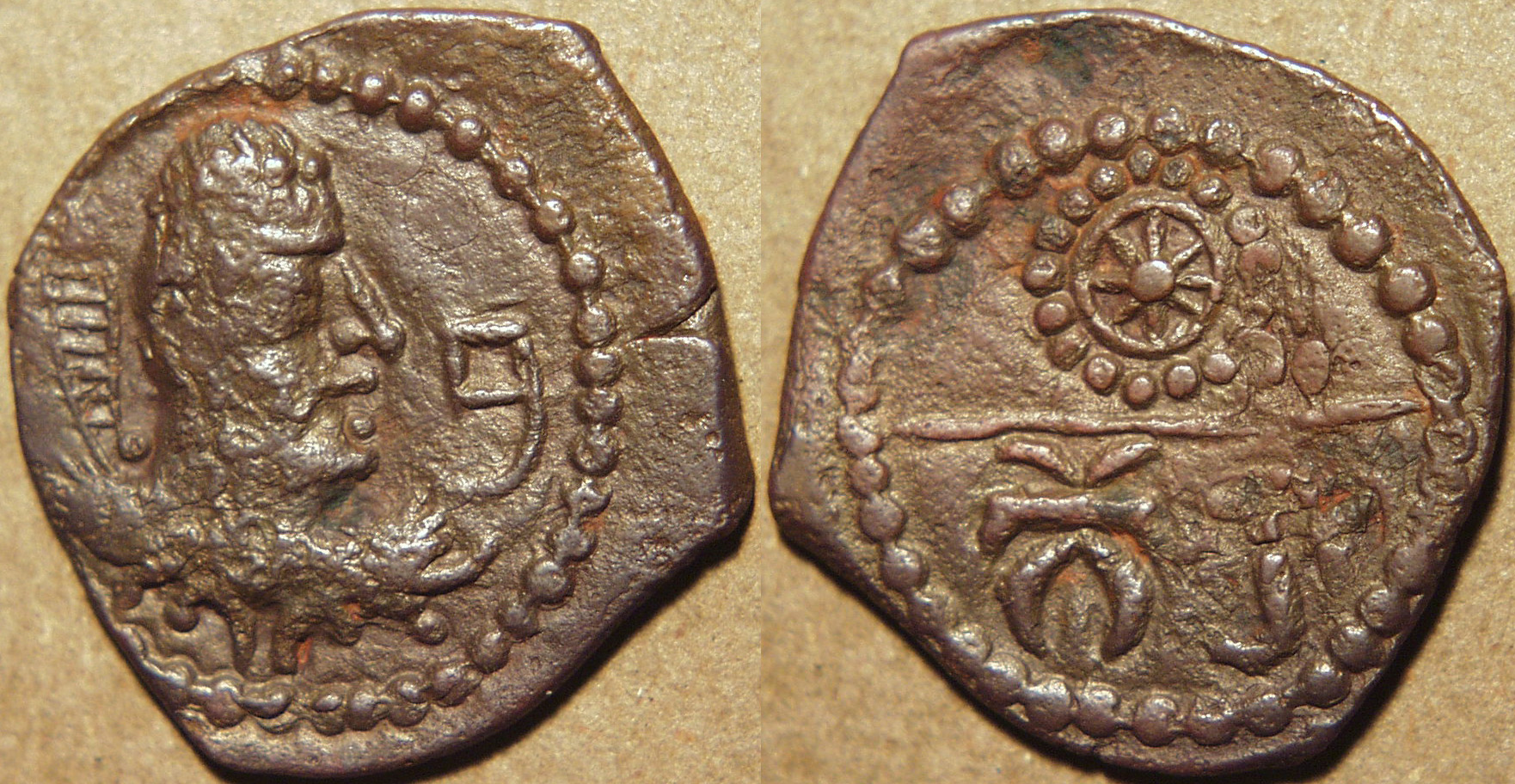
|
Toramana copper unit, c. early-6th century
Bare-headed bust of king right, wearing necklace with ribbon ends,
Brahmi letter at right: bu or bra, dotted border around /
Solar disc in upper register, Brahmi legend below: tora, dotted border around
Weight: 3.16 gm, Diameter: 22 mm., Die axis: 12 o'clock
Ref: Göbl 120
|
 |
I present first some copper coins of Toramana, because these seem closely related to the anonymous
coins of the early Alchon period. Note the tall-headed bust with no diadem, the ribbon ends being attached to the necklace instead, as on the
early Alchon coins. Note, however, the absence of the "bull"/lunar tamgha. On the reverse,
we have a very Gupta style design, with a symbol above and the king's name below. Compare to the first copper coin on the
Chandragupta II page. The important conclusion we can draw from these coins is that
Toramana's coinage drew its inspiration partly from Gupta coins, but otherwise directly from the early anonymous coins, not from the coins of Khingila. This
reinforces the insight gained from the Schøyen copper scroll, that Khingila and Toramana (and, indeed, Javukha and Mehama also) ruled in parallel
rather than in sequence.
|
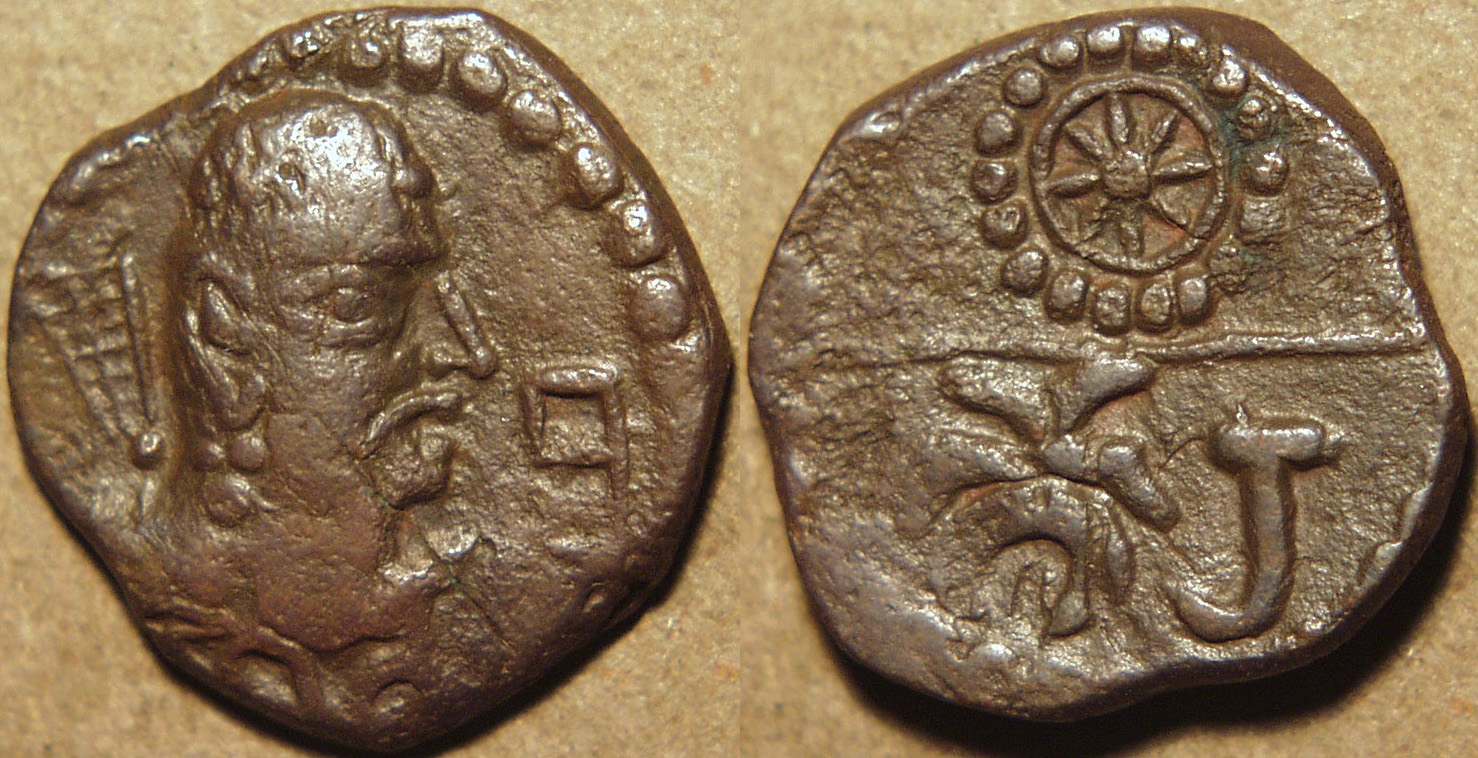
|
Toramana copper unit, c. early-6th century
Bare-headed bust of king right, wearing necklace with ribbon ends,
Brahmi letter at right: bu or bra, dotted border around /
Solar disc in upper register, Brahmi legend below: tora, dotted border around
Weight: 3.80 gm, Diameter: 17 mm., Die axis: 11 o'clock
Ref: Göbl 120
|
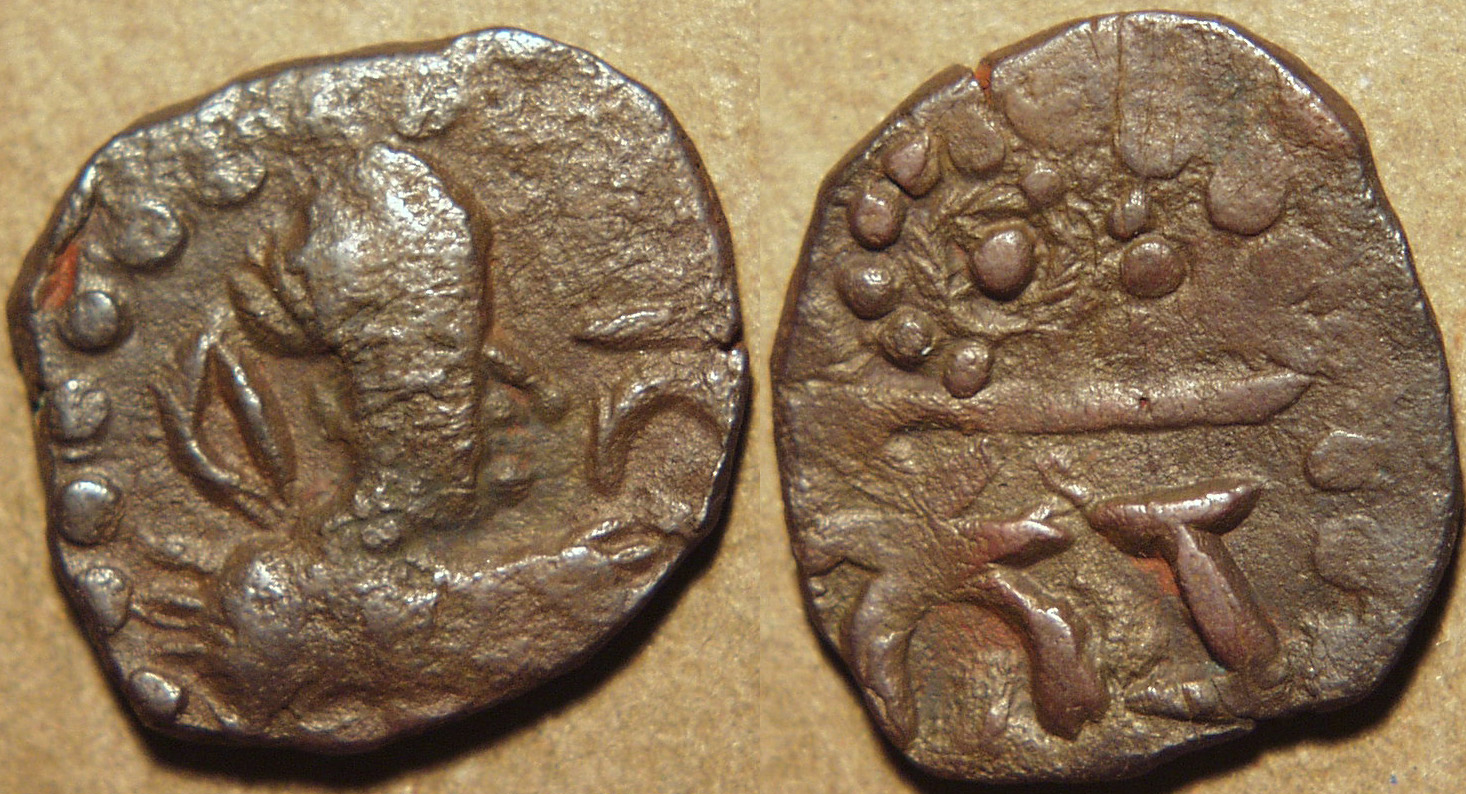
|
Toramana copper unit, c. early-6th century
Bare-headed bust of king right, wearing necklace with ribbon ends,
Brahmi letter at right: bu or bra, dotted border around /
Solar disc in upper register, Brahmi legend below: tora, dotted border around
Weight: 2.99 gm, Diameter: 18 mm., Die axis: 10 o'clock
Ref: Göbl 122
|
 |
A very crude type with the Brahmi letter ta on the obverse.
|
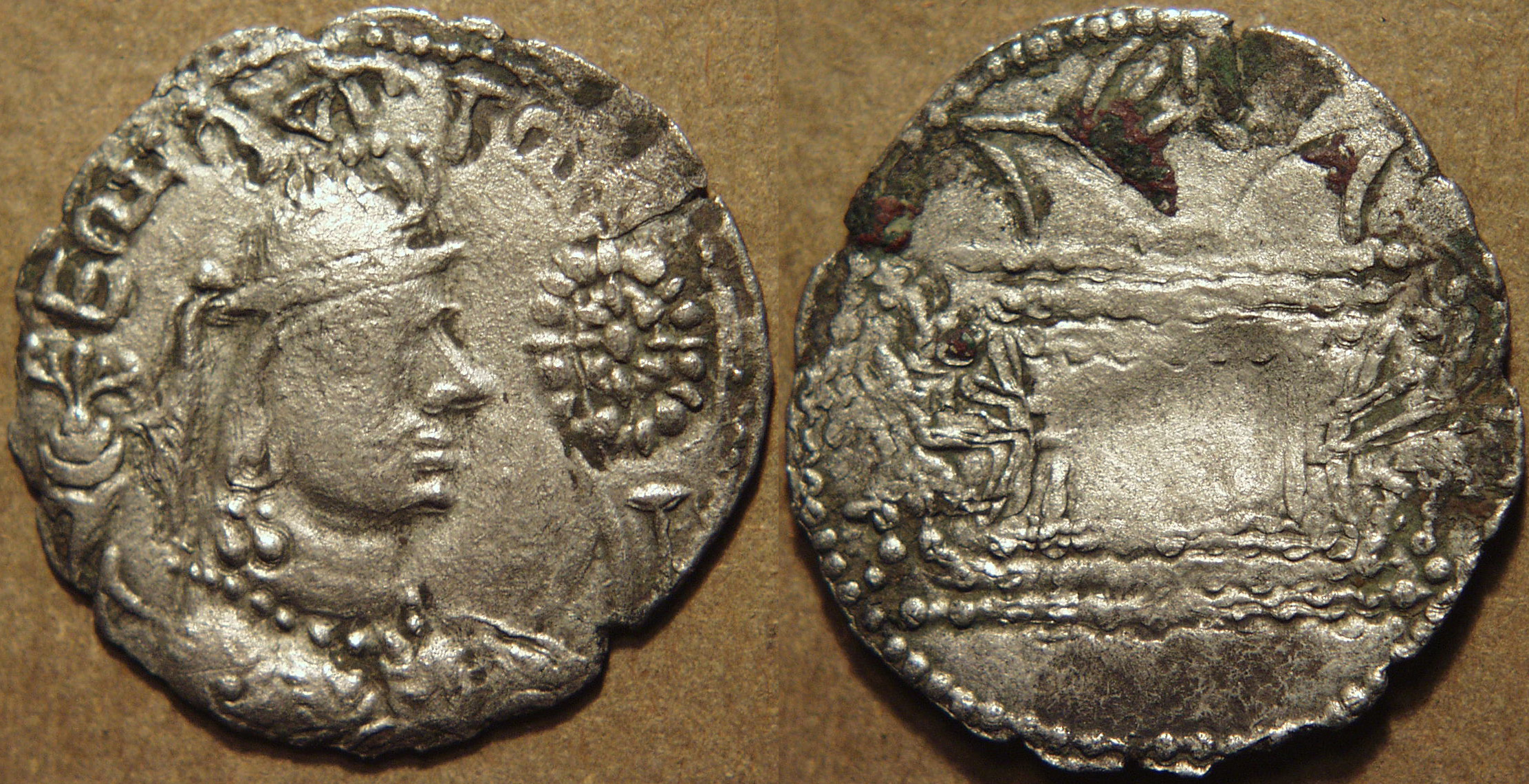
|
Toramana ? silver drachm, c. early-6th century
Crowned bust of king right, wearing diadem with crescent forehead ornament
land hanging ribbon ends, unar crescents on shoulders, solar disc at right,
conch at left, Brahmi legend above: jayatu torana, dotted border around /
Large fire altar flanked by attendants, dotted border around
Weight: 3.59 gm, Diameter: 27.5 mm., Die axis: 10 o'clock
Ref: Göbl --- (unpublished)
|
 |
This previously unpublished coin may be the first known Sasanian style silver drachm
of Toramana. The reading of the legend is not absolutely definitive because of the state of the coin. jayatu is clear. The next letter is
either to or bha, followed by ra. The following letter is partially obscured, but appears to be a hard na. Thus the
legend on the coins appears to read jayatu torana or jayatu bharana. So the question is, whose coin is this?
I believe there is a strong possibility that the coin is of Toramana. It is possible that the intended legend was jayatu toramana and that the
celator accidentally omitted the letter ma, or intentionally left it out seeing that he was out of space. Other aspects of the coin make it very
consistent with this attribution. There are two important connections between this coin and the known copper coins of Toramana, shown above.
First, the prominent symbol is a solar disc; second, there is no "bull"/lunar tamgha, an absolute necessity on all other Alchon coinage, but
missing here and on Toramana's copper coins. Further, it is worth remembering that Toramana's name is shortened to tora on the copper
coins. So, for these reasons, the coin appears to be connected to Toramana's copper coins. In addition, there is a close similarity between this coin
and the well-known silver drachms of Mihirakula (shown below). The portrait styles are very similar on the two types, they both feature two
prominent symbols (left and right), and they both feature a legend that passes continuously over the king's head, something not seen on any coin of
Khingila, Javukha or Mehama. Further, the legend includes the word jayatu, as do the coins of Mihirakula. Since we know Mihirakula was
Toramana's son, we would expect his coins to resemble his father's in design and style. So once again we have strong evidence favoring the
attribution of this coin to Toramana.
|
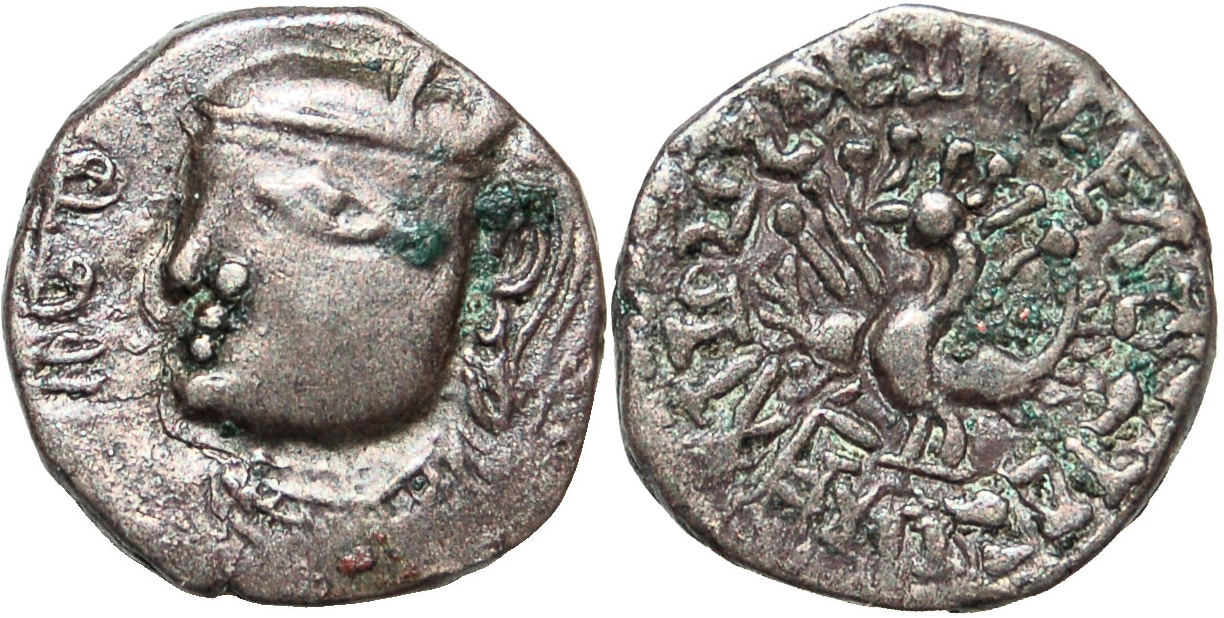
|
Toramana silver drachm, c. early-6th century
Head of king left, in Gupta style, date before:
Stylized peacock standing facing, with wings spread,
Brahmi legend around (at 1 o'clock): vijitavaniravanipati sri toramana divam jayati
Weight: 2.49 gm, Diameter: n.a., Die axis: n.a.
Ref: Göbl 119
|
 |
Toramana also issued silver drachms modeled on the madhyadesa types of the Guptas, with
a similar legend, but placing the head facing left instead of right. Compare this coin with the madhyadesa types of Skandagupta. (photo courtesy Shailendra Bhandare)
|
 |
 |
 |
Mihirakula |
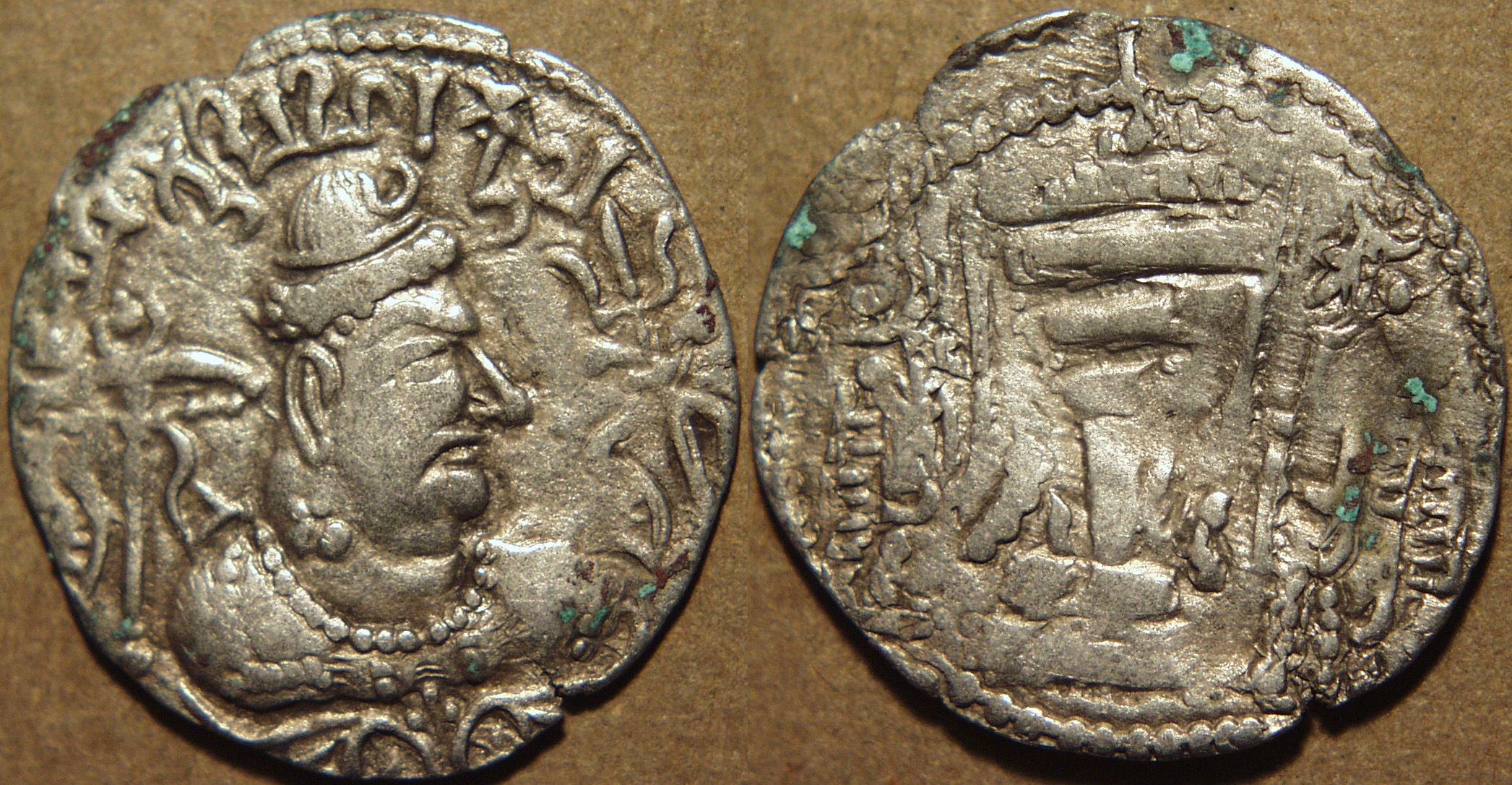
|
Mihirakula silver drachm, c. early-6th century
Crowned bust of king right, wearing diadem with crescent forehead ornament
and hanging ribbon ends, lunar crescents on shoulders, ribboned trident at right,
sun standard at left, Brahmi legend above: jayatu mihirakula, dotted border around
Fire altar flanked by attendants, dotted border around
Weight: 3.33 gm, Diameter: 25 mm., Die axis: 3 o'clock
Ref: Göbl 310
|
 |
We know from the Gwalior Fort inscription that Mihirakula was Toramana's son and this coin
provides corroboration of that fact: it is clearly derived from the previous coin of Toramana. I have already commented on
the close similarities between the two coins. Note that the dominant symbol on Toramana's coin, the solar disc, is represented horizontally here as
the top of the standard at left.
|
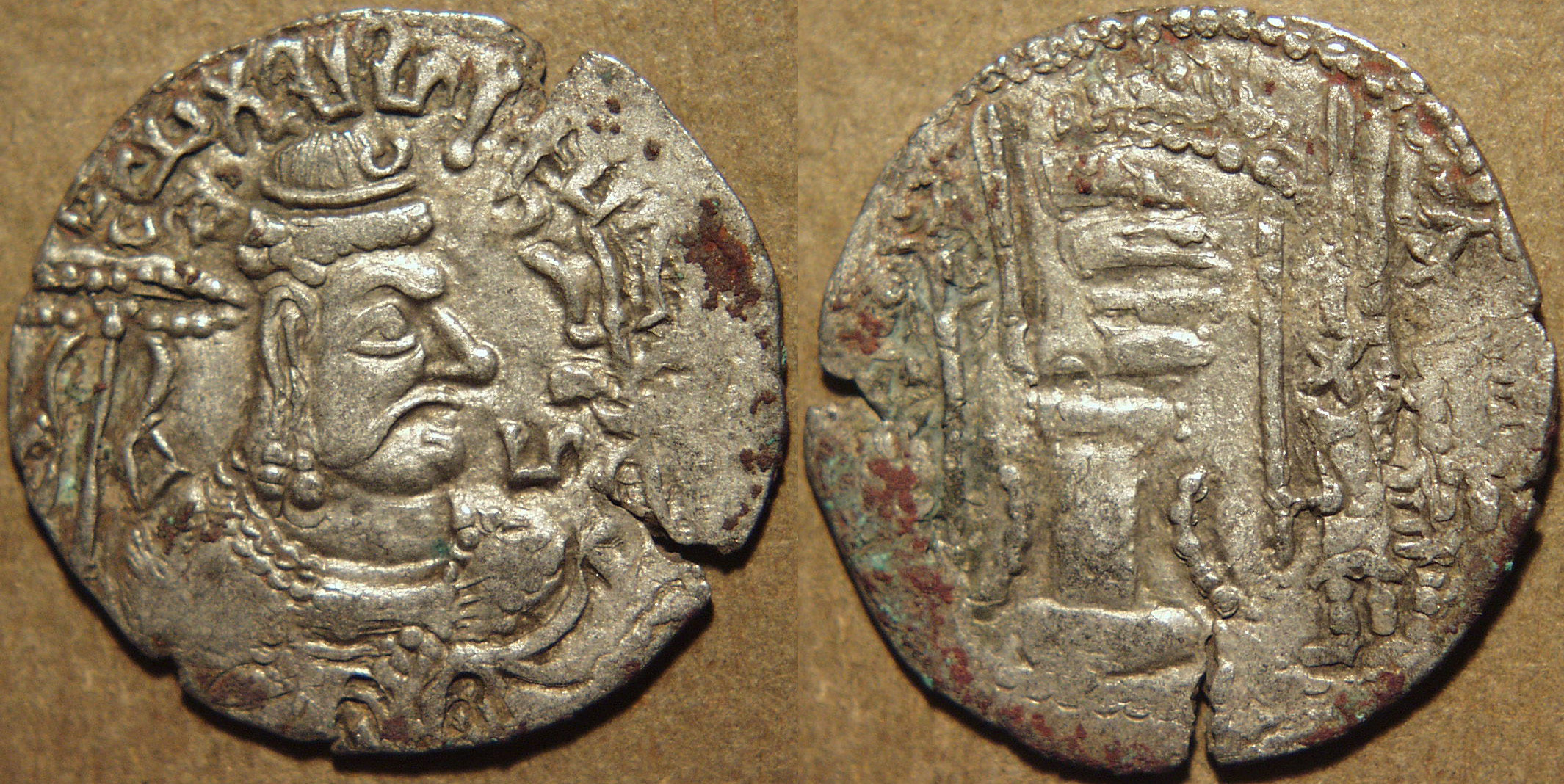
|
Mihirakula silver drachm, c. early-6th century
Crowned bust of king right, wearing diadem with crescent forehead ornament
and hanging ribbon ends, lunar crescents on shoulders, ribboned trident at right,
solar standard at left, Brahmi legend above: jayatu mihirakula, Brahmi letter ha at right
Fire altar flanked by attendants, dotted border around
Weight: 3.58 gm, Diameter: 26 mm., Die axis: 2:30 o'clock
Ref: Göbl 310
|
 |
This variety has an additional letter ha in front of the king's chin.
|
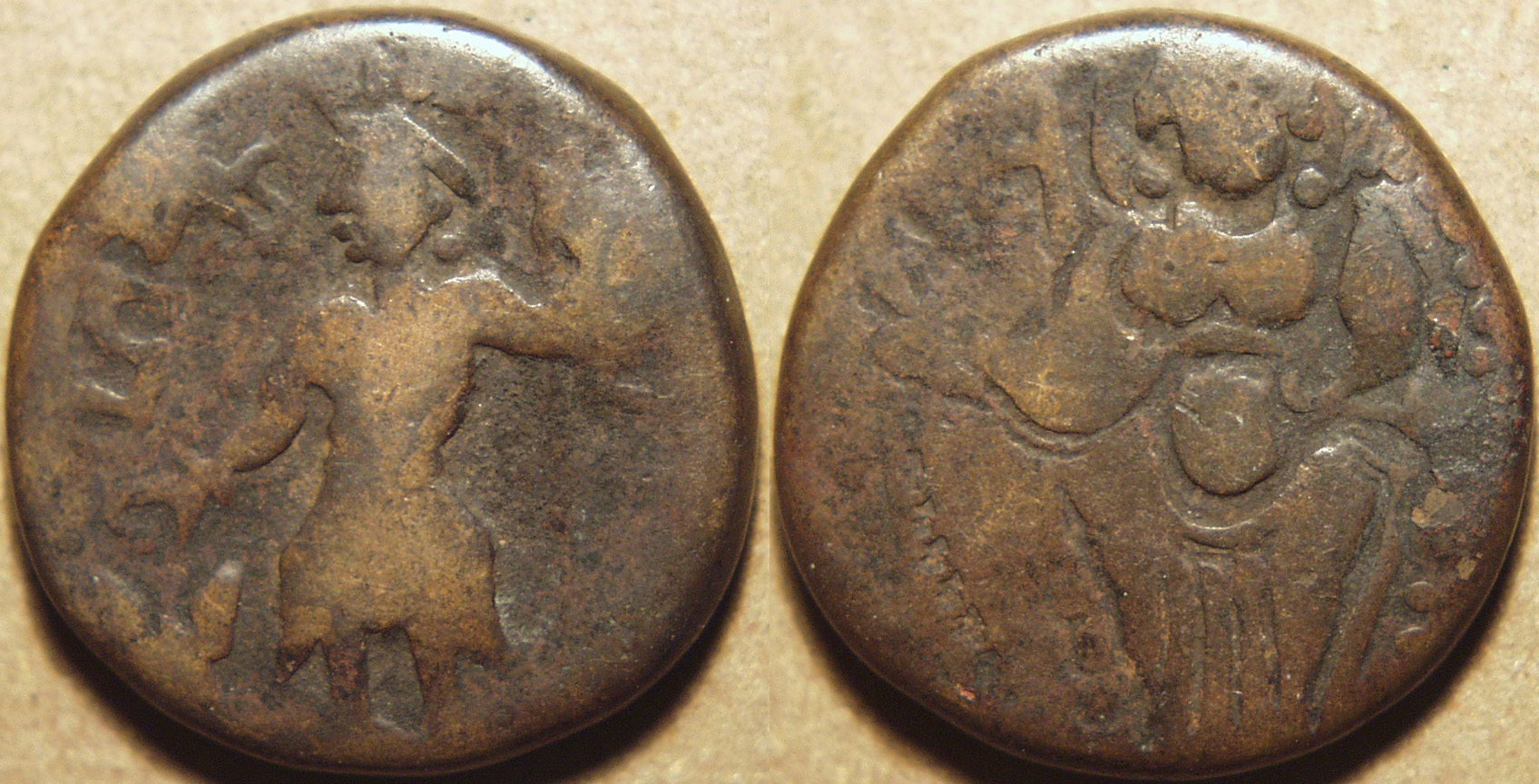
|
Mihirakula copper unit, c. early-6th century
Kushan style king standing facing, holding scepter in left hand,
right hand sacrificing at fire altar left, Brahmi legend left: shahi mihi, right: ragula
Goddess of plenty Ardochsho (Lakshmi) enthroned facing,
holding cornucopia and diadem
Weight: 7.23 gm, Diameter: 20 mm., Die axis: 12 o'clock
Ref: MAC 3779
|
 |
Mihirakula did issue copper coins on the Gupta model, but I do not have such a coin to show.
In addition, he issued these Kushan style coins, based on prototypes such as the coins of
Gadahara. These coins were probably issued in Kashmir once Mihirakula was in power there.
|
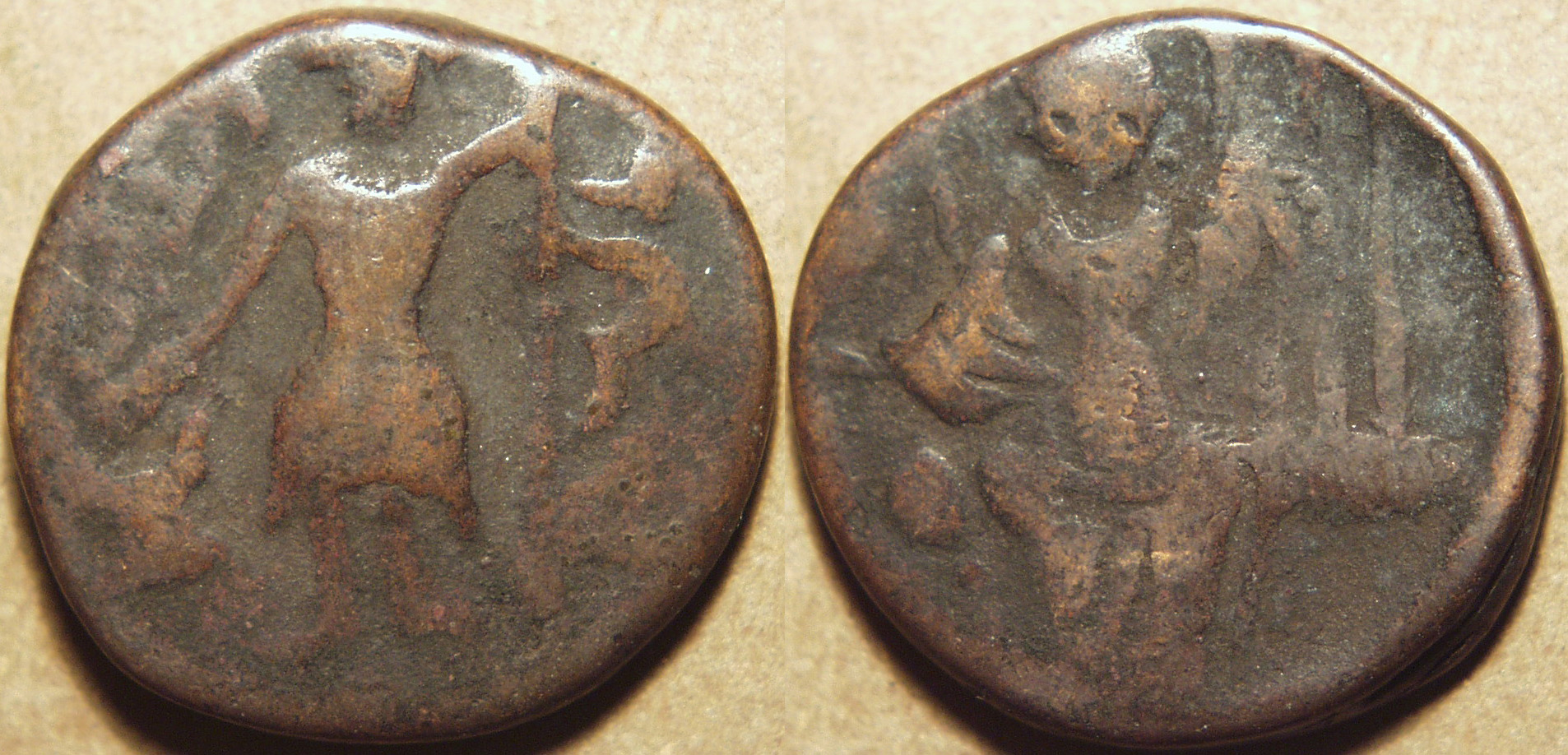
|
Mihirakula copper unit, c. early-6th century
Kushan style king standing facing, holding scepter in left hand,
right hand sacrificing at fire altar left, Brahmi legend left: shahi mihi, right: ragula
Goddess of plenty Ardochsho (Lakshmi) enthroned facing,
holding cornucopia and diadem
Weight: 7.94 gm, Diameter: 22 mm., Die axis: 12:30 o'clock
Ref: MAC 3779
|
 |
While the previous coin showed the left side of the legend better, this coin shows the right
side better.
|
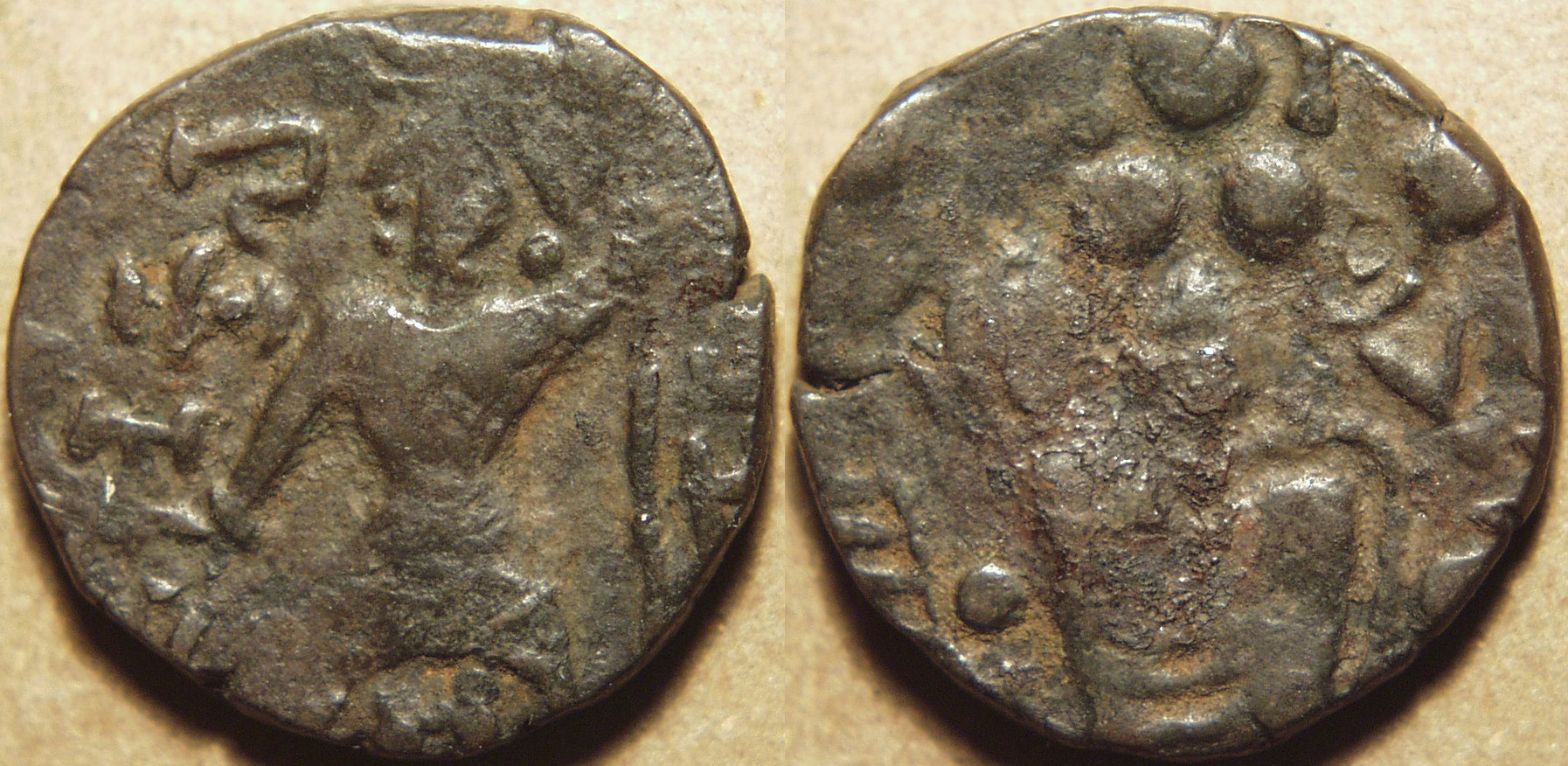
|
Mihirakula copper unit, c. early-6th century
Kushan style king standing facing, holding scepter in left hand,
right hand sacrificing at fire altar left, Brahmi legend left: mihirakula
Goddess of plenty Ardochsho (Lakshmi) enthroned facing,
holding cornucopia and diadem
Weight: 7.73 gm, Diameter: 21 mm., Die axis: 1 o'clock
Ref: MAC 3782
|
 |
A variant in cruder style with the entire king's name at left and spelled mihirakula instead of
the mihiragula seen on the previous two coins.
|
 |
 |
 |
Unknown king: Vaishravana ? |
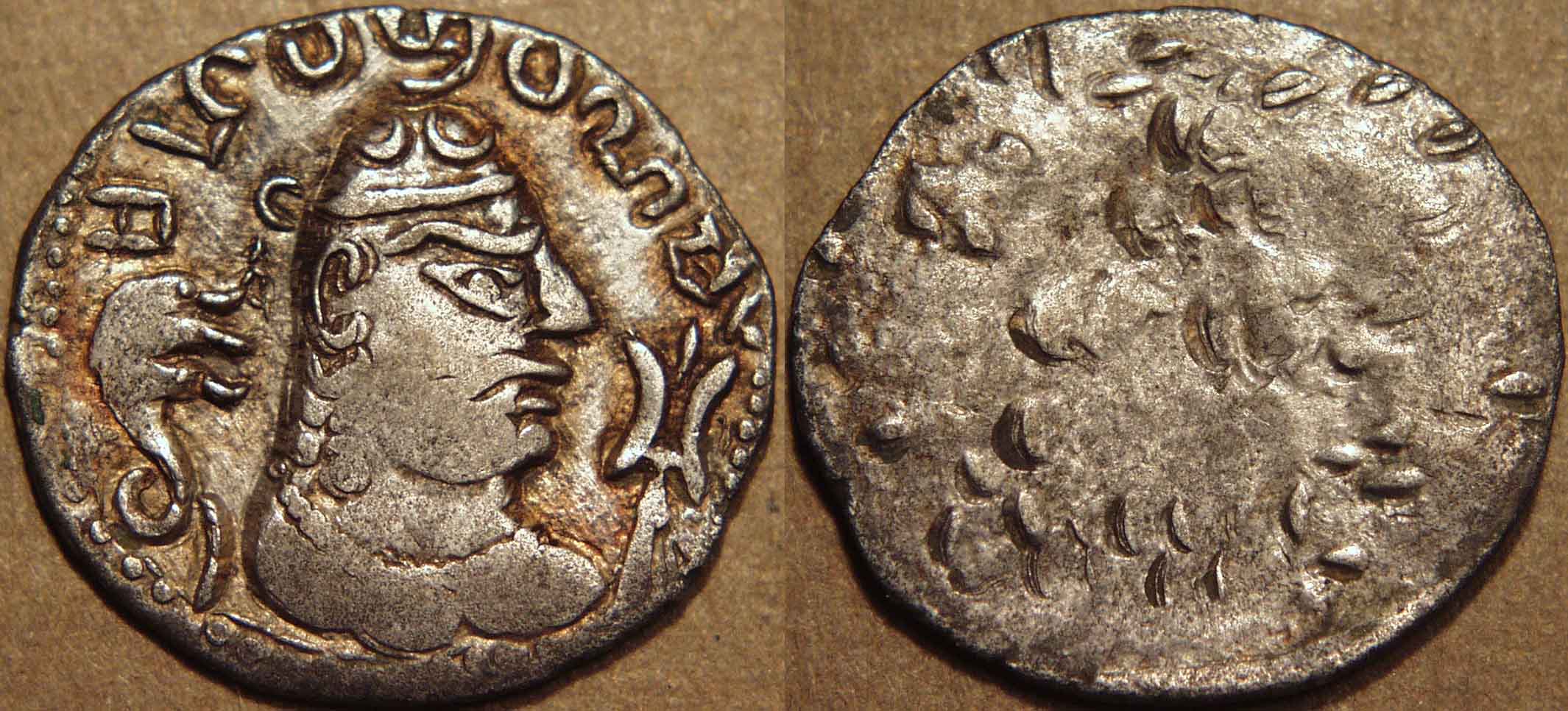
|
Vaishravana ? silver drachm, c. mid-6th century
Crowned bust of king right, wearing diadem with crescent ornaments
trident at right, three-headed snake at left, Brahmi legend above: shahi vaishravanashya ?
Reverse obliterated, but presumably fire altar with armed attendants
Weight: 3.82 gm, Diameter: 25 mm., Die axis: ? o'clock
Ref: Göbl ---
|
 |
An amazing coin with a legend, which I (thanks to help from Shailen Bhandare) am tentatively
reading shahi vaishravanashya. I believe this coin belongs in the group with Toramana and Mihirakula for one simple reason: it has a legend that
passes in a continuous arc above the king's head, a feature of the drachms of Toramana and Mihirakula not seen on any coins of Khingila, Javukha or
Mehama, or coins related to those. Further, this coin has two prominent symbols ... continuing the trident from Mihirakula's coins and replacing the
chakra standard with a surprising symbol that has been seen as a yak-tail fan or whisk (unlikely) or a three-headed snake, which is what it looks
like to me. This may be a representation of the multi-headed snake god Shesha. Göbl shows a few other coins types (types 108-110) that also have
similar features and probably belong to this series; he reads the king's name on these coins as Baysara. The name "Baysara" does seem to have some
similarity to the name Vaishravana, so the two coin types may therefore be related.
|
|
|